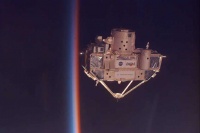CRISTA-SPAS 2
From The Space Library
 | |
| Organization | German Space Agency (Federal Republic of Germany),NASA Office of Mission to Planet Earth (United States) |
|---|---|
| Mission type | Earth Science |
| Launch date | August 7, 1997 |
| Launch vehicle | STS-85 |
| Carrier rocket | Space Shuttle |
| Launch site | Cape Canaveral, United States |
| COSPAR ID | 1997-039B |
| Mass | 3510 kg |
| Alternate Names | Cryogenic IR Spectrometers and Telescopes for the Atmosphere, Shuttle Palette Satellite 2, 24890 |
| Additional Information | Here |
| PDMP Information | Here |
| Telecommunications Information | Here |
CHRISTA-SPAS 2 (Cryogenic Infrared Spectrometers and Telescopes for the Atmosphere-Shuttle Pallet Satellite 2) was a German-American free-flying module that was released from the Shuttle Remote Manipulator System (RMS) on STS 85 to monitor atmospheric constituents (ozone, etc.) of the middle atmosphere by means of infrared spectrometers. It was retrieved by the Shuttle RMS after nine days of free flying in the vicinity of the Shuttle. During its free flight about 66 minirockets and balloons were launched by the United States and Germany to concurrently monitor the same regions of the atmosphere as the spacecraft did. Initial orbital parameters of the spacecraft were close to those of the Shuttle. The primary experiment was the CRISTA, a system of three telescopes and four spectrometers to measure infrared radiation emitted by the Earth's middle atmosphere. A complementary instrument called MAHRSI (Middle Atmosphere High Resolution Spectrograph Investigation) was also carried on the payload together with a passive experiment called SESAM (Surface Effects Sample Monitor). MAHRSI measured ultraviolet radiation emitted and scattered by the Earth's atmosphere. Two additional experiments were mounted on the SPAS and were activated during free-flight. The Mini Dual Earth Sensor (MiDES) was used to gather operational data of the Earth horizon positions, and the Interferometry Program Experiment-II (IPEX-II) to measure the vibration of the SPAS structure.
